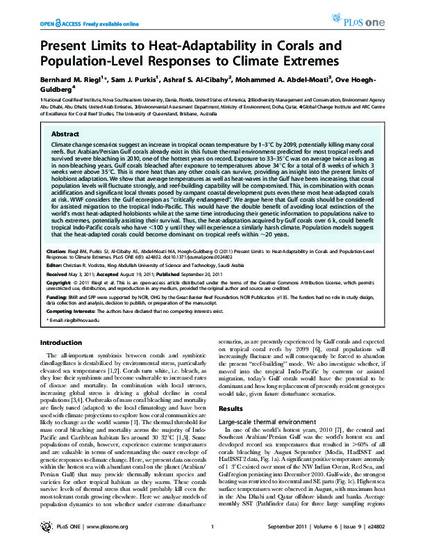
- Bleaching,
- Coral reefs,
- Corals,
- Death rates,
- Gulfs,
- Ocean temperature,
- Qatar,
- Summer
Climate change scenarios suggest an increase in tropical ocean temperature by 1–3°C by 2099, potentially killing many coral reefs. But Arabian/Persian Gulf corals already exist in this future thermal environment predicted for most tropical reefs and survived severe bleaching in 2010, one of the hottest years on record. Exposure to 33–35°C was on average twice as long as in non-bleaching years. Gulf corals bleached after exposure to temperatures above 34°C for a total of 8 weeks of which 3 weeks were above 35°C. This is more heat than any other corals can survive, providing an insight into the present limits of holobiont adaptation. We show that average temperatures as well as heat-waves in the Gulf have been increasing, that coral population levels will fluctuate strongly, and reef-building capability will be compromised. This, in combination with ocean acidification and significant local threats posed by rampant coastal development puts even these most heat-adapted corals at risk. WWF considers the Gulf ecoregion as “critically endangered”. We argue here that Gulf corals should be considered for assisted migration to the tropical Indo-Pacific. This would have the double benefit of avoiding local extinction of the world's most heat-adapted holobionts while at the same time introducing their genetic information to populations naïve to such extremes, potentially assisting their survival. Thus, the heat-adaptation acquired by Gulf corals over 6 k, could benefit tropical Indo-Pacific corals who have <100 y until they will experience a similarly harsh climate. Population models suggest that the heat-adapted corals could become dominant on tropical reefs within ~20 years.

©2011 Riegl et al. This is an open-access article distributed under the terms of the Creative Commons Attribution License, which permits unrestricted use, distribution, and reproduction in any medium, provided the original author and source are credited.